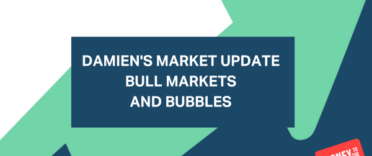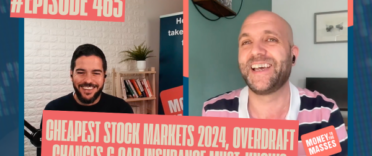The 130th episode of my weekly YouTube show where I discuss what is happening in investment markets and what to look out for. This week I talk about the factors that are pushing markets to the edge.
Each show lasts between 5-10 minutes and is aimed at DIY investors (including novices) seeking contemporary analysis to help them understand how investment markets work.
Subscribe to my YouTube channel to receive my weekly analysis of investment markets or alternatively, you can listen via my weekly Midweek Markets podcast below.
Midweek Markets weekly podcast
Other ways to watch, listen and subscribe
You can listen to other episodes and subscribe to the show by searching 'Money to the Masses' on Spotify or by using the following links:
Abridged transcript - Midweek Markets episode 130
Probably no more suitable word to sum up market action in the last week than ‘WOW!’
A hell of a lot has happened in the last 7 days in investment markets so I’m going to pick through the bones of it on this week’s show. If you recall, a week ago the market was more concerned about Jerome Powell his second term as the Chair of the US Federal Reserve than they were of a new wave of Covid particularly in Europe. Things have changed a lot since then.
The biggest story which swept the feet from under bond and equity markets was the announcement of Omicron, the new Covd-19 variant that has 50 mutations and more than 30 on the spike protein that most vaccines target. The speed at which governments moved to impose new travel and domestic restrictions was a result of fears that Omicron could evade the body’s immune system and existing Covid vaccines.
The reaction from markets was immediate with bond yields collapsing (meaning bond prices rallied) while equity markets slumped as investors rushed to haven assets. The 10 year US treasury yield fell below 1.5% (good news for bond investors) but remained above 1.46% ensuring the recent uptrend in yields remained intact. In the UK the 10 year gilt yield tumbled back to 0.84%, a 1 month low, in a matter of hours. The price of oil collapsed 12% back below its 200 day moving average, a particularly bearish sign. Bitcoin continued its recent fall, and at one point was down 20% below its November high. Meanwhile most developed world equity markets fell 3-5% from recent highs (all-time highs in some instances) in the space of 24 hours.
So spooked were investors about the economic impact of a new potential vaccine-evading Covid variant, that no matter what you held in your investment portfolio you would have taken a hefty blow last Friday, the day after news broke about Omicron. The only real exceptions would have been funds exposed to gold and government bonds, but even the former ultimately took a hit this week as I will come onto later.
Heading into the end of last week, the market was in the grip of fear and based on the market's reaction you would have thought we were back in February 2020. Of course it's far too early to say either way, especially as the scientific analysis of Omicron has yet to be completed.
Even if we are on the precipice of a March 2020 style event history gives us a hint about what might come next. In 2020, central banks hit the panic buttons and flooded the market with liquidity via QE and interest rate cuts, which ultimately propelled equity markets to their recent all-time highs. Indeed, following the news about Omicron, money markets initially pushed back their bets on how soon and how quickly the US Federal Reserve will raise interest rates. It was the same for other central banks too, especially in the UK where in a matter of days the market began pricing in that the Bank of England base rate would be around 0.75% this time next year rather than the 1%+ the market was predicting just days earlier.
Moving into this week equity markets attempted a rebound (with bond yields moving higher along with equity markets) and tried to move on from Omicron. But then Powell decided to go in two-footed and take the market’s legs away again in a style reminiscent of Vinnie Jones in his hayday.
In this week's press conference Powell made his most hawkish comments on monetary policy since the pandemic began, stating that it was time to retire the t-word (transitory) and that the Fed would need to act to curb persistent inflation and taper QE quicker than planned. The timing of his comments seem strange, coming just as the market is trying to assess the potential impact of Omicron. Indeed the Fed admitted that Omicron is not yet baked into their economic outlook. We will find out in the coming weeks if that will change.
The net result was that Omicron combined with a more hawkish pivot from the Fed sent equity markets into a tailspin. The S&P 500 is now some 4% lower than its recent high, currently sitting around 4500. In Europe, the German DAX is down almost 7% from its high two weeks ago. Meanwhile the FTSE 100 is flirting with the key 7000 level again. The dollar rallied which was bad for commodities, especially gold. Even supposed havens, with the exception of certain government bonds, were not safe this week.
Powell’s comments increase the chance that the current bout of equity market volatility turns into something more worrisome. As a benchmark, if the S&P 500 falls below 4500 then it might be time to worry. At the same time that equity markets have been falling, bond prices have rallied as investors increase their bets that Omicron will hit economic growth. The 10 year US treasury yield is now down to 1.4%, effectively ending the uptrend in bond yields we’ve seen since the summer.
Omicron and the Fed pivot has changed the backdrop meaning that fear is the overriding emotion in investment markets right now. Where we go from here depends a lot on how dangerous Omicron turns out to be. If the news is good news, then expect a positive response from equity markets. If not and central banks tighten into a potential slowdown then things could get ugly. Right now, depending on which indicators you use, equity markets are oversold. I explain this in more detail to 80-20 Investor subscribers this week in my latest research article which you can read if you sign up for a free trial. Historically it suggests we are due a rebound.
But right now markets are on the edge, with a number of equity and bond market indices (both at an index level and sector level) sitting at critical technical support levels. It’s a bit like the pandemic itself, will Omicron spark a similar move to February 2020? Much depends on what science tells us about the new variant in the coming days and weeks. If the news is bad then things could come crashing down. If they do then the Fed and other central banks will need to pivot once again. Ironically investors would probably be quite happy with that based upon history. If it’s good news then it could be the catalyst for the seasonal Santa rally, unless the Fed derails things.



